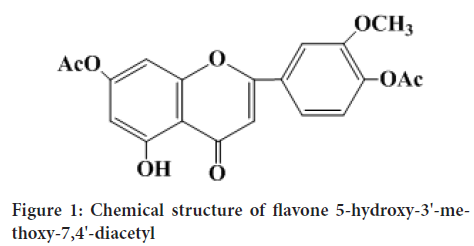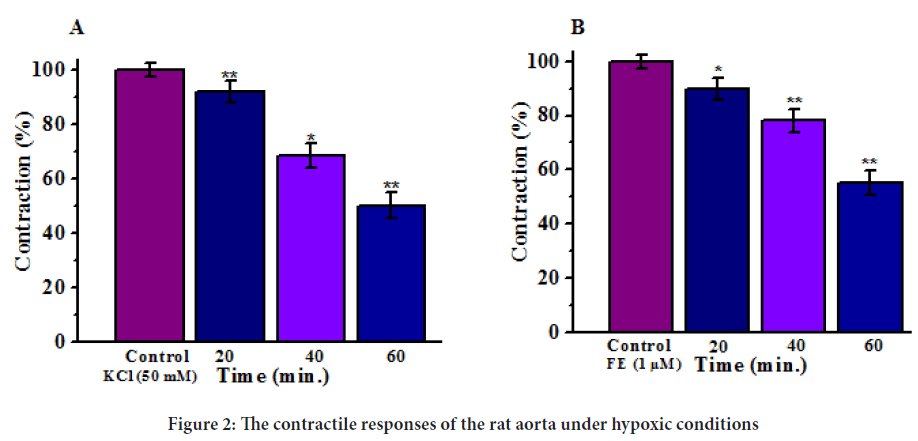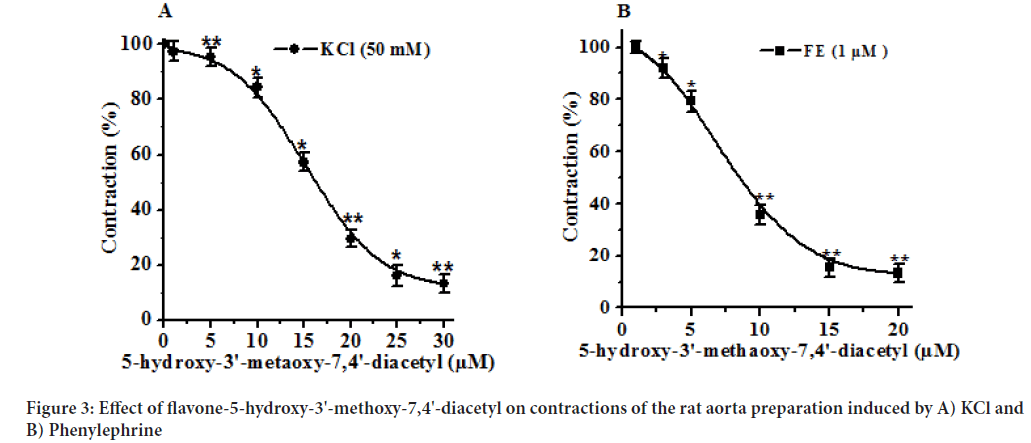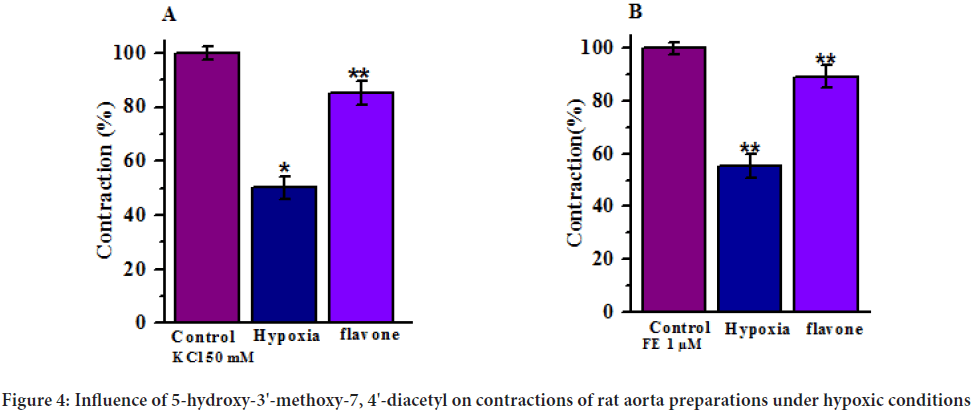Research Article - (2021) Volume 12, Issue 11
The Effect of 5-Hydroxy-3'-Methoxy-7, 4'-Diacetyl on Aortic Smooth Muscle under Hypoxic Conditions
Mirzayeva Yulduzkhon Takhirzhonovna1, Omonturdiev Sirojiddin Zoirovich2*, Zaripov Abdisalim Abdikarimovich1, Usmanov Pulat Bekmuratovich1, Esimbetov Adilbay Tlepovich1 and Eshbakova Komila Alibekovna2Abstract
The aim of this study was to examine the effect of flavone-5-hydroxy-3'-a metaoxy-7,4'-diacetyl derivative of the flavonoid chrysoeriol isolated from the Inula capsicum plant on the contractile activity of rat aor ta preparations under hypoxic conditions in vitro and modern ideas about the molecular mechanisms of hypoxia development, its maintenance and the possibilities of pharmacological correction.
Keywords
Hypoxia, Aorta, Ion channels, Receptors, Phenylephrine
Introduction
The pathogenesis of ischemic heart disease is complex, where hypoxia plays a key role, developing in conditions of lack of oxygen in violation of coronary circulation. Oxygen deficiency negatively affects the functional state of smooth muscle cells of the coronary arteries as a result of which their reactivity to regulatory stimuli that control their contractile activity is significantly impaired.
At present, large-scale studies are being carried out in leading scientific centers of the world aimed at identifying and characterizing the pharmacological effects of biologically active compounds of plant origin. A large number of different alkaloids and flavonoids with a pronounced relaxing effect have been isolated and characterized from various plants (Luna-Vázquez FJ, etal., 2013). Considering the capillary protective ability of flavonoids, they are today considered as the most promising candidates for creating effective drugs for the correction of pathologies of the cardiovascular system in ischemia (Barnaulov OD, 2010; Lu N, et al., 2003; Selmi C, etal., 2008).
In preliminary experiments, it was found that flavone-5-hydroxy-3'-methoxy-7,4'-diacetyl in a wide range of concentrations does not affect the basal tone of rat aorta preparations. However, in further experiments, we found that the studied flavone effectively relaxes the rat aorta preparations previously contracted with 50 mM KCl and phenylephrine, i.e., has a relaxing effect. In this case, the relaxant effect was more pronounced in 5-hydroxy-3'-methoxy-7,4'-diacetyl and began to manifest itself already at its concentration of 5 μM, while the relaxant effect of chrysoeriol was less pronounced and was manifested at its concentration of 5 μM (Omonturdiev SZ, etal., 2017). As noted above, the pathogenesis of ischemic heart disease is complex, where hypoxia plays a key role, which develops in conditions of a lack of oxygen in violation of the coronary circulation. Oxygen deficiency negatively affects the functional state of Smooth Muscle Cells (SMC) of coronary arteries as a result of which their reactivity to regulatory stimuli that control their contractile activity is significantly impaired (Karaki H and Weiss GB, 1984). We have previously found that some alkaloids as flavonoids exhibit pronounced vasodilating activity and significantly inhibit the contraction of the rat aortic rings caused by KCl and Phenylephrine (PE) (Mirzayeva YT, et al., 2016).
Objective
To study the effect of flavone-5-hydroxy-3'-methoxy-7,4'-diacetyl, a derivative of the flavonoid chrysoeriol, isolated from the Inula capsicum plant, on the contractile activity of rat aorta preparations under hypoxic conditions in vitro (Figure 1).

Figure 1: Chemical structure of flavone 5-hydroxy-3'-methoxy-7,4'-diacetyl
Materials and Methods
Animals and aortic rings preparation
Male albino rats weighing 200 g to 250 g were anesthetized with sodium pentobarbital and killed by decapitation. All animal care and experimental procedures were approved by the Committee for Animal Experiments of Institute of Biophysics and Biochemistry at the National University of Uzbekistan. After brief anesthesia with sodium pentobarbital, the rat was decapitated and the thoracic aorta was isolated. The connective tissue was removed and rings 3 mm long were mounted vertically under isometric conditions in a 5 ml organ bath perfused with Krebs solution containing (in mM): NaCl 118.3, KCl 4.7, CaCl2 2.5, MgSO4 1.2, NaH2PO4 1.2, NaHCO3 25.0, EGTA 1.0 and glucose 11.1 (pH 7.35). Krebs solution was maintained at 37°C ± 0.5°C and continuously bubbled with a mixture of 95% O2 and 5% CO2. During the experiments, while working with experimental animals, International principles of the Helsinki Declaration and the rules of human attitudes towards animals were completely followed. Ethical committee permission (No.2).
Vascular tension recording
An initial load of 1 g was applied and maintained throughout a 60 min equilibration period. During equilibration, the bathing solution was changed every 15 min with readjustment of baseline tension, when necessary. The tension was recorded on a pen recorder (Endim 621,02, Germany) via force-displacement transducers (FT03, Grass Instru ment Ma, USA).
Statistical analysis
All data are expressed as means ± S.E.M. The concentration of the flavone-5-hydroxy-3'-methoxy-7,4'-diacetyl evoking 50% of maximal relaxation (IC50) and the value of maximal relaxation (Emax) (expressed as a percentage of a previous contraction induced by the contractile agent) were calculated using a non-linear iterative curve-fitting procedure. Differences between means were statistically compared using Student's t-test and/or one-way ANOVA. The significance level considered in all tests was 0.05. All values were obtained using Graph-Pad Prism 5.01 software (Graph Pad Software Inc., USA).
Results and Discussion
Indeed, as can be seen in figure, the force of contraction of the rat aorta induced by (KCl 50 mM) noticeably decreases during deoxygenation of the perfusion solution with nitrogen. At the same time, the maximum decrease in KCl-induced contractions of the aorta was observed after 60 minutes of saturation of the solution with nitrogen, where it was 50.2 ± 4.8% of control. These data may indicate that under conditions of hypoxia there is a decrease in the level of [Ca2+]i in the SMC, as a result of a violation of their entry into the SMC through the voltage-dependent Ca2+channels of the plasmalemma. which are activated under KCl conditions (Bolton TB, 1979). At the same time, it was found that under conditions of hypoxia, the reaction of SMCs to the action of α-adrenergic receptor agonists, which play a leading role in ensuring the contractile activity of smooth muscles, significantly decreases (Mirzayeva YT, et al., 2016). Indeed, as can be seen in (Figure 2), depending on the degree of deoxygenation of the perfusion solution with nitrogen, the contractile responses of aortic preparations to the selective α-adrenergic receptor agonist, phenylephrine, are markedly reduced. At the same time, the maximum decrease (up to 55.2% ± 4.5%, from control) in the response of aortic preparations to the vasoconstrictor effect of phenylephrine was observed after 60 minutes of saturation of the perfusion solution with nitrogen. Phenylephrine is an effective vasoconstrictor and by stimulating α-adrenergic receptors, it activates phospholipase C, which hydrolyzes phosphatidylinositol diphosphate and produces inositol 1,4,5-triphosphate (IP3), the main mediator of inositol 1,4,5-triphosphate receptor (IP3R) (Karaki H, et al., 1997). At the same time, IP3, interacting with IP3R and activating it, provides the release of Ca2+ ions from the SR, which triggers the process of SMC contraction. А. Contractile responses of rat aorta preparations induced by KCl (50 mM) under hypoxic conditions.B. Contractile responses of rat aorta preparations induced by phenylephrine (1 μM) under hypoxic conditions. On the ordinate, the force of contraction of the rat aorta preparations, expressed in%, of the control obtained under the action of KCl (50 mM) and phenylephrine (1 μM), under normoxic conditions and taken as 100%. In all cases, P<0.05 (n=5).
Figure 2: The contractile responses of the rat aorta under hypoxic conditions
In this regard, the suppression of the vasoconstrictor effect of phenylephrine on the contraction of aortic preparations under conditions of hypoxia is evidence of damage to the intracellular signaling system activated by stimulation of α-adrenergic receptors The results of these control experiments show that under conditions of hypoxia in the SMC of the rat aorta, there are significant violations of the function of Ca2+-transporting systems located in the plasmalemma and in the SR. At the same time, these violations are accompanied by a decrease in the level of [Ca2+]i, as a result of which the force of contraction of the SMC, which was observed by us using preparations of the rat aorta, is suppressed. At the same time, as we have shown, the use of rat aorta preparations in experiments under hypoxic conditions in vitro can be useful in assessing disturbances in the functioning of intracellular signaling systems activated upon stimulation of α-adrenergic receptors.
Thus, the results of these control experiments show that the assessment of changes in the contractile activity of rat aorta preparations under hypoxic conditions in vitro is an adequate approach for screening and characterizing the antihypoxic efficacy of various compounds. To confirm the adequacy of the approach used by us, the features of the action of flavone-5-hydroxy-3'-methoxy-7,4'-diacetyl on the contractile activity of aortic preparations were studied under various experimental conditions. At the same time, it has been shown that 5-hydroxy-3'methoxy-7,4'-diacetyl effectively relaxes rat aorta preparations previously contracted with KCl solutions and phenylephrine (Figure 3).
Figure 3: Effect of flavone-5-hydroxy-3'-methoxy-7,4'-diacetyl on contractions of the rat aorta preparation induced by A) KCl and B) Phenylephrine
It was noted that the relaxant effect of 5-hydroxy-3'-methoxy-7,4'-diacetyl is more pronounced on preparations of the aorta precontracted by α-adrenergic receptors agonists.
Indeed, in our experiments, 5-hydroxy-3'-methoxy-7,4'-diacetyl effectively reduced the contractions of aortic preparations. The relaxant effect of flavone was dose-dependent, and with an increase in flavone concentration in the range of 5-30 μM, the force of contraction of the rat aorta preparation induced by 50 mM KCl decreased from 4.5% ± 3.2% to 86.9% ± 3.3%. At the same time, we found that flavone under conditions of PE-induced contracture can relax the preparations of the aorta; however, its relaxant effect, as in the conditions of KCl-induced contracture, was less pronounced in comparison with the effect of 5-hydroxy-3'-methoxy-7, 4'-diacetyl.
It should be noted that the relaxant effect of 5-hydroxy-3'-methoxy7,4'-diacetyl under the conditions of PE-induced contact also has a dose-dependent character and at its concentration of 5 μM it caused relaxation of the aortic preparation by 21.7% ± 4.1%, and the maximum relaxation up to 86.7% ± 3.5% was observed at a concentration of 20 μM.
On the ordinate, the force of contraction of the rat aorta preparations, expressed in%, of the control obtained under the action of 50 mM KCl and 1 μM phenylephrine, was taken as 100%. The abscissa shows the concentration of 5-hydroxy-3'-methoxy-7,4'-diacetyl (μM). In all cases, P<0.05 (n=5-6).
The results of these experiments indicate that the relaxant effect of 5-hydroxy-3'-methoxy-7,4'-diacetyl, under conditions of PE-induced contracture, is mainly due to its effect on the transport of Ca2+ ions through the receptor-driven Ca2+ channels of the plasma membrane. and their release from the SR of the SMC, the presented data indicate the inhibition of 5-hydroxy-3'-methoxy-7,4'-diacetyl of this pathway of increasing [Ca2+]i. Thus, the relaxing effect of 5-hydroxy-3'-methoxy7,4'-diacetyl, which is due to the inhibition of the entry of Ca2+ ions into the SMC through the voltage-dependent Ca2+ channels of the plasmalemma and their release from the SR, possibly underlies its cardioprotective effect.
Hypoxia is a key link in numerous disorders of body functions, including behavioral ones (Lukyanova LD and Ushakov IB, 2004; Chesnokova NP, et al., 2006; Chesnokova NP, et al., 2006; Salminen A, et al., 2016). Hypoxia can have an independent etiology, but it can act as a concomitant factor both in diseases associated with dysfunction of the respiratory and cardiovascular systems, as well as in the transport function of blood and in the vast majority of other pathologies, where it aggravates their course. Despite the noticeable progress in the treatment of ischemic heart disease, the problem of developing new drugs that can effectively protect cardiomyocytes from ischemic damage, as well as positively affect the course of the disease itself, remains very urgent (Glezer MG, et al., 2013; Rylova NV and Oganezova LG, 2012). Considering this feature of the action of 5-hydroxy-3'-methoxy-7,4'diacetyl, we studied its effects on the contractions of aortic preparations induced by KCl solutions and phenylephrine under hypoxic conditions. As you can see in figure, during preliminary incubation of aortic preparations with 5-hydroxy-3'-methoxy-7,4'-diacetyl, the inhibitory effect of hypoxia on contractions induced by KCl solutions is noticeably reduced. At the same time, in the presence of 5-hydroxy3'-methoxy-7,4'-diacetyl in the incubation medium, the decrease in the force of contraction of the aortic preparations under hypoxic conditions was 85.2% ± 4.5%, compared to 50.2% ± 4, 2%, if absent. Considering that KCl-induced contractions of aortic preparations are caused by the entry of Ca2+ ions through voltage-dependent Ca2+channels, the observed effect of 5-hydroxy-3'-methoxy-7,4'-diacetyl, under conditions of hypoxia, may indicate its influence on these channels.
A. Effect of 5-hydroxy-3'-methoxy-7,4'-diacetyl on KCl-induced contractions of rat aortic preparations under hypoxic conditions. B. Effect of 5-hydroxy-3'-methoxy-7,4'-diacetyl on the contractions of rat aorta preparations induced by phenylephrine (1 μM) under hypoxic conditions. On the ordinate axis, the force of contraction of the rat aorta preparations, expressed in%, of the control obtained with the action of KCl (50 mM) and 1 μM phenylephrine and taken as 100%. In all cases, P<0.05 (n=3-4)
However, a similar protective effect of 5-hydroxy-3'-methoxy-7,4'-diacetyl was observed by us in experiments with phenylephrine, in which it also effectively neutralized the effects of hypoxia. At the same time, the decrease in the force of contraction of aortic preparations induced by phenylephrine during hypoxia, reaching 55.2% ± 4.5% of the control, in the presence of 5-hydroxy-3'-methoxy-7,4'-diacetyl, decreased to only 89% ± 4.2% (Figure 4).
Figure 4: Influence of 5-hydroxy-3'-methoxy-7, 4'-diacetyl on contractions of rat aorta preparations under hypoxic conditions
Because the development of aortic contractions induced by phenylephrine is due to an increase in [Ca2+]i, provided mainly by Ca2+ ions released from the SR, the results of these experiments are evidence of the influence of 5-hydroxy-3'-methoxy-7,4'.
Conclusion
Thus, the data obtained in experiments with the flavone 5-hydroxy-3'-methoxy-7,4'-diacetyl show that this flavone effectively prevents hypoxia-induced damage to the contractile activity of the rat aorta. Diacetyl, on the intracellular signaling system activated by stimulation of α-adrenergic receptors. These effects of the flavone used are due to its influence on the voltage-dependent Ca2+channels of the plasmalemma and the channels of the sarcoplasmic reticulum, which regulate [Ca2+]i in the SMC. Such a corrective effect of flavone on the functional activity of these Ca2+ channels is possibly due to their complex effect on the state of membranes, energy metabolism, and on the guanylate cyclase system of the endothelium producing nitric oxide, which together provides its cardioprotective activity. In general, the results obtained in this series of experiments indicate that the use of the developed by us method for assessing the effect of compounds on the contractile activity of rat aortic smooth muscle under hypoxic conditions in vitro is a fairly adequate approach to characterize potential antihypoxic agents.
Acknowledgments
This work was supported by a grant А-6-004 from the Coordinating Committee for Development of Science and Technology under the Cabinet of Ministers of the Republic of Uzbekistan.
References
- Luna-Vázquez FJ, Ibarra-Alvarado C, Rojas-Molina A, Rojas-Molina I, Zavala-Sánchez MÁ. Vasodilator compounds derived from plants and their mechanisms of action. Molecules. 2013; 18(5): 5814-5857.
- Barnaulov OD. Herbal medicine for patients with cardiovascular diseases. JAMA. 2010; 240.
- Lu N, Zhang Y, Gao Z. Nitrite-glucose-glucose oxidase system directly induces rat heart homogenate oxidation and tyrosine nitration: Effects of some flavonoids. Toxicol In vitro. 2009; 23(4): 627-633.
- Selmi C, Cocchi CA, Lanfredini M, Keen CL, Gershwin ME. Chocolate at heart: The anti‐inflammatory impact of cocoa flavanols. Моl Nutr Food Res. 2008; 52(11): 1340-1348.
- Omonturdiev SZ, Mirzayeva YT, Usmanov PB, Komilov BJ, Eshbakova KA. Mechanism of relaxant effect of chrysoeriol flavonoid on rat aorta preparation. Infection Immunity and Pharmacology. 2017; 2:150-154.
- Karaki H, Weiss GB. Calcium channels in smooth muscle. Gastroenterology. 1984; 87(4): 960-970.
- Mirzayeva YT, Sultankhodzaev MN, Usmanov PB. The possible role of the Na+/Ca2+ exchanger in the vasorelaxant effect of 1‑O‑benzoylkarakoline, a diterpenoid alkaloid, in rat aortic rings. Eur Sci Rev. 2016; 3: 12-16.
- Bolton TB. Mechanisms of action of transmitters and other substances on smooth muscle. Physiol Rev. 1979; 59(3): 606-718.
- Karaki H, Ozaki H, Hori M, Mitsui-Saito M, Amano KI, Harada KI, et al. Calcium movements, distribution, and functions in smooth muscle. Physiol Rev. 1997; 49(2): 157-230.
- Lukyanova LD, Ushakov IB. Problems of Hypoxia: Molecular, Physiological, and Medical Aspects. Voronezh. 2004; 8-51.
- Chesnokova NP, Ponukalina YV, Bizenkova MN. Molecular/cellular mechanisms of cytotoxic effects of hypoxia. Pathogenesis of Hypoxic Necrobiosis. 2006; 7: 32-40.
- Chesnokova NP, Ponukalina EV, Bizenkova MN. Modern conceptions of hypoxia pathogenesis. Hypoxia classification and the starters of its development. Sovremennye Naukoyomkie Tekhnologii. 2006; 5: 23.
- Salminen A, Jouhten P, Sarajärvi T, Haapasalo A, Hiltunen M. Hypoxia and GABA shunt activation in the pathogenesis of Alzheimer's disease. Neurochem Int. 2016; 92: 13-24.
- Glezer MG, Astashkin EI, Novikov MV. Treatment of stable angina pectoris: Current state of the art. Farmateka. 2013; 18: 31-38.
- Rylova NV, Oganezova LG. The role of trimetazidine in the treatment of stable angina pectoris. Russian Medical Journal. 2012; 5: 1-3.
Author Info
Mirzayeva Yulduzkhon Takhirzhonovna1, Omonturdiev Sirojiddin Zoirovich2*, Zaripov Abdisalim Abdikarimovich1, Usmanov Pulat Bekmuratovich1, Esimbetov Adilbay Tlepovich1 and Eshbakova Komila Alibekovna22Department of Bioorganic Chemistry, Institute of Bioorganic Chemistry, Academy of Sciences of Uzbekistan, Tashkent, Uzbekistan
3Department of Chemistry, Institute of Chemistry of Plant Substances, Uzbek Academy of Sciences, Tashkent, Uzbekistan
Received: 06-Apr-2021 Accepted: 20-Apr-2021 Published: 27-Apr-2021
Copyright: This is an open access article distributed under the terms of the Creative Commons Attribution License, which permits unrestricted use, distribution, and reproduction in any medium, provided the original work is properly cited.
ARTICLE TOOLS
- Dental Development between Assisted Reproductive Therapy (Art) and Natural Conceived Children: A Comparative Pilot Study Norzaiti Mohd Kenali, Naimah Hasanah Mohd Fathil, Norbasyirah Bohari, Ahmad Faisal Ismail, Roszaman Ramli SRP. 2020; 11(1): 01-06 » doi: 10.5530/srp.2020.1.01
- Psychometric properties of the World Health Organization Quality of life instrument, short form: Validity in the Vietnamese healthcare context Trung Quang Vo*, Bao Tran Thuy Tran, Ngan Thuy Nguyen, Tram ThiHuyen Nguyen, Thuy Phan Chung Tran SRP. 2020; 11(1): 14-22 » doi: 10.5530/srp.2019.1.3
- A Review of Pharmacoeconomics: the key to “Healthcare for All” Hasamnis AA, Patil SS, Shaik Imam, Narendiran K SRP. 2019; 10(1): s40-s42 » doi: 10.5530/srp.2019.1s.21
- Deuterium Depleted Water as an Adjuvant in Treatment of Cancer Anton Syroeshkin, Olga Levitskaya, Elena Uspenskaya, Tatiana Pleteneva, Daria Romaykina, Daria Ermakova SRP. 2019; 10(1): 112-117 » doi: 10.5530/srp.2019.1.19
- Dental Development between Assisted Reproductive Therapy (Art) and Natural Conceived Children: A Comparative Pilot Study Norzaiti Mohd Kenali, Naimah Hasanah Mohd Fathil, Norbasyirah Bohari, Ahmad Faisal Ismail, Roszaman Ramli SRP. 2020; 11(1): 01-06 » doi: 10.5530/srp.2020.1.01
- Manilkara zapota (L.) Royen Fruit Peel: A Phytochemical and Pharmacological Review Karle Pravin P, Dhawale Shashikant C SRP. 2019; 10(1): 11-14 » doi: 0.5530/srp.2019.1.2
- Pharmacognostic and Phytopharmacological Overview on Bombax ceiba Pankaj Haribhau Chaudhary, Mukund Ganeshrao Tawar SRP. 2019; 10(1): 20-25 » doi: 10.5530/srp.2019.1.4
- A Review of Pharmacoeconomics: the key to “Healthcare for All” Hasamnis AA, Patil SS, Shaik Imam, Narendiran K SRP. 2019; 10(1): s40-s42 » doi: 10.5530/srp.2019.1s.21
- A Prospective Review on Phyto-Pharmacological Aspects of Andrographis paniculata Govindraj Akilandeswari, Arumugam Vijaya Anand, Palanisamy Sampathkumar, Puthamohan Vinayaga Moorthi, Basavaraju Preethi SRP. 2019; 10(1): 15-19 » doi: 10.5530/srp.2019.1.3









